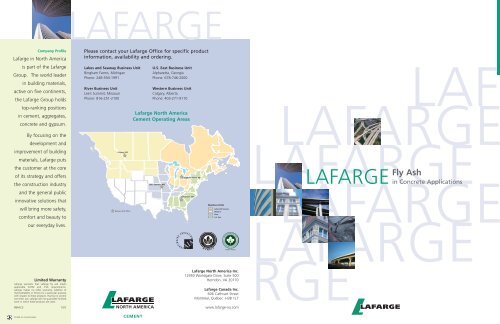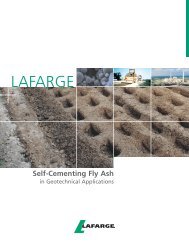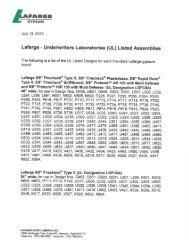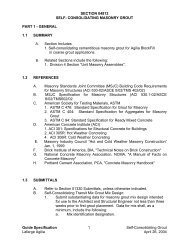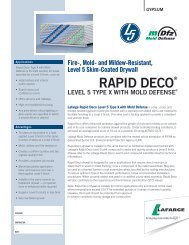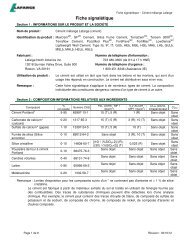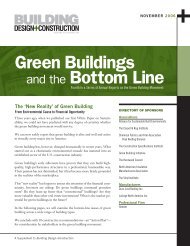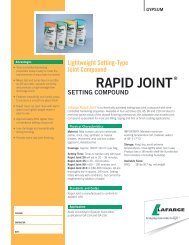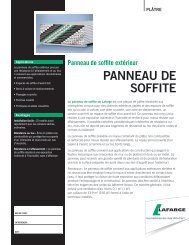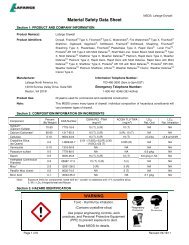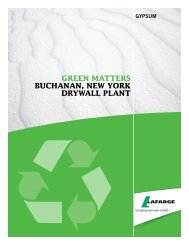LAF LAFARGE LAFARGE LAFARGE RGE
Fly Ash: Concrete Applications.pdf - Lafarge
Fly Ash: Concrete Applications.pdf - Lafarge
- No tags were found...
Create successful ePaper yourself
Turn your PDF publications into a flip-book with our unique Google optimized e-Paper software.
Printed on recycled paperCompany ProfileLafarge in North Americais part of the LafargeGroup. The world leaderin building materials,active on five continents,the Lafarge Group holdstop-ranking positionsin cement, aggregates,concrete and gypsum.By focusing on thedevelopment andimprovement of buildingmaterials, Lafarge putsthe customer at the coreof its strategy and offersthe construction industryand the general publicinnovative solutions thatwill bring more safety,comfort and beauty toour everyday lives.Limited WarrantyLafarge warrants that Lafarge fly ash meetsapplicable ASTM and CSA requirements.Lafarge makes no other warranty, whether ofmerchantability or fitness for a particular purposewith respect to these products. Having no controlover their use, Lafarge will not guarantee finishedwork in which these products are used.PBFACE 1/07<strong>LAF</strong>A<strong>RGE</strong>Please contact your Lafarge Office for specific productinformation, availability and ordering.Lakes and Seaway Business UnitBingham Farms, MichiganPhone: 248-594-1991River Business UnitLee’s Summit, MissouriPhone: 816-251-2100Calgary, ABBusiness Unit OfficeCEMENTU.S. East Business UnitAlpharetta, GeorgiaPhone: 678-746-2000Western Business UnitCalgary, AlbertaPhone: 403-271-9110Lafarge North AmericaCement Operating AreasLee’s Summit, MOBingham Farms, MIAlpharetta, GABusiness UnitsLakes and SeawayWesternRiverU.S. EastLafarge North America Inc.12950 Worldgate Drive, Suite 500Herndon, VA 20170Lafarge Canada Inc.606 Cathcart StreetMontréal, Québec H3B 1L7www.lafarge-na.com<strong>LAF</strong><strong>LAF</strong>A<strong>RGE</strong><strong>LAF</strong>A<strong>RGE</strong><strong>LAF</strong>A<strong>RGE</strong><strong>LAF</strong>A<strong>RGE</strong><strong>RGE</strong>Fly Ashin Concrete Applications
<strong>LAF</strong>A<strong>RGE</strong>What isFly Ash?Fly ash is an extremely finepowder consisting of sphericalparticles less than 50 micronsin size. Fly ash is one of theconstruction industry's mostcommonly used pozzolans.Pozzolans are siliceous orsiliceous/alumino materialspossessing the ability toform cementitious compoundswhen mixed with lime(calcium hydroxide or CaOH)and water.The word "pozzolan" isnamed after the small Italiantown of Pozzuoli where someof the first hydraulic cementswere created over 2000 yearsago. The ancient Romansused volcanic ash as a pozzolanin their structures, some ofwhich still stand today.In North America over26 million tons of pozzolansare consumed each year inconcrete, concrete products,and geotechnical applications.F LY A SH IN C ONCRETEWhere Does FlyAsh Come From?Fly ash is produced by coal-fired power plants duringthe combustion of coal. Fly ash consists mainly ofinorganic glassy particles formed from the mineralmatter in the coal. During combustion, these mineralsare heated to a molten state and chemically combinedand solidified while suspended in the exhaust gas.They are then collected by electrostatic precipitatorsor bag houses.Fly ash is classified based on the chemical and physicalcomposition of the ash.According to ASTM, Class F fly ash is normally producedfrom burning anthracite or bituminous coal that meetsthe applicable requirements for this class. This classof fly ash has pozzolanic properties. Class C fly ash isnormally produced from lignite or subbituminous coalthat meets the applicable requirements. This class offly ash, in addition to having pozzolanic properties,also has some cementitious properties.According to CSA, Type F fly ash has a calcium oxidecontent of less than 8%, Type CI fly ash has a calciumoxide content from 8% to 20%, and Type CH fly ashhas a calcium oxide content above 20%.Reference ACI 211.1 to evaluate the performanceof a given fly ash in concrete and to establish propermix proportions for a specific application. Trial batchadjustments should also be considered.<strong>LAF</strong>A<strong>RGE</strong><strong>LAF</strong>A<strong>RGE</strong><strong>LAF</strong>A<strong>RGE</strong><strong>LAF</strong>A<strong>RGE</strong><strong>LAF</strong>A<strong>RGE</strong><strong>LAF</strong>A<strong>RGE</strong>Consistent Performance<strong>LAF</strong>A<strong>RGE</strong>Fly ash performance in concrete is affected by such variables as coal composition, combustionconditions, and ash collection systems. Power plants operating under stable load conditionstend to produce more uniform fly ash than when operating under variable load. LafargeNorth America's fly ash quality control and assurance program ensures construction industrystandards are met.A PPLICATIONSFly Ash and the EnvironmentAs a coal combustion product (CCP), use of fly ash in concrete offersadvantages that go beyond performance. Using fly ash reduces theamount of by-product material electric utilities landfill and enablesmanufacturers to minimize mining and processing virgin materials,thereby reducing the emission of carbon dioxide.Concrete containing fly ash can qualify for the LEED Material andResources credit MR-4, Recycled Content.Fly Ash in Portland CementConcreteWhen portland cement is mixed with water, most of the cement formsinsoluble cementitious compounds. Calcium hydroxide (CaOH) isformed as part of this reaction. When fly ash is introduced into concrete,it reacts with the CaOH to form additional cementitious compounds.According to ACI 232.2R-9, "the shape, size, particle-size distribution,and density of fly ash particles influence the properties of freshlymixed, unhardened concrete, and the strength development and otherproperties of hardened concrete. This is due in part to the influence ofparticle characteristics on the water demand in the concrete mixture."Factors that influence the effectiveness of fly ash include:• chemical and physical composition• alkali-hydroxide concentration• morphology of fly ash particles• fineness• initial hydration process• reduction in mixing water requirementsIn a properly proportioned mix, fly ash can improve many of theproperties of concrete, including:• improved workability and consolidation• increased flexural and compressive strengths• improved pumpability• reduced drying shrinkage• reduced bleeding and segregation• decreased permeability• increased resistance to ASR and sulfate attack• improved economics• reduced water requirementsFly Ash –A Solid IdeaLafarge –A Solid Supplier!"Meet customer needs." It's such a businessbasic, yet so necessary for success. This is whyLafarge is a reliable source of supply. We'vedeveloped a company-wide sourcing systemthat transports product from areas with surplusesto those in need. Lafarge has invested in over225,000 tons of ash storage, hundreds of railcars, and dozens of pneumatic truck trailers.In addition to reliable product supply, ourcustomers need reliable product performance.To meet this need, Lafarge has establisheda rigorous quality assurance program, rigidproduct standards, and an on-going research anddevelopment program that provides continuousresearch studies and product tests at Lafargelaboratories in the U.S., Canada and Europe.


